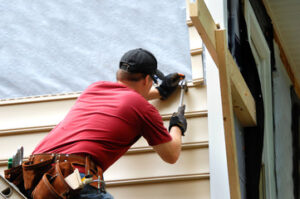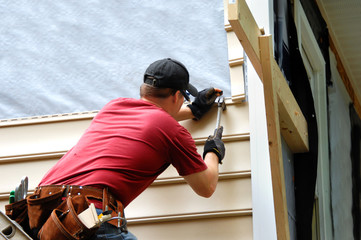Damage to your siding is a big deal. It can lead to significant costs and compromise the integrity of your home’s structure.
Depending on the extent of the damage, it may be necessary to hire a professional siding repair contractor. A reputable company will provide an accurate estimate based on your specific needs and budget constraints. Contact Siding Repair Charleston SC for professional help.
Small holes and cracks in vinyl siding should be repaired as soon as possible to prevent moisture penetration. This can lead to rot, mold growth, and other serious problems. Using a patching technique, or applying vinyl siding caulk, can effectively seal these areas and restore your home’s curb appeal.
Before attempting to repair a hole or crack in your vinyl siding, you should first gather the necessary tools and materials. These include vinyl adhesive caulk, replacement siding (if necessary), nails and screws, a utility knife, and paint. You will also want to make sure that the caulk and replacement siding match the color of your existing vinyl as closely as possible.
Locating the Damage
Use a utility knife to carefully cut away the damaged section of siding. If the hole or crack is large, you may need to add a new piece of siding to match the original size and style. Before cutting the new panel, measure the width of the damaged area and add four inches to allow for a two-inch overlap on each side. This will ensure that the new panel fits properly and isn’t too tight.
Cleaning the Area
Clean the area around the hole with mild soap and water and let it dry completely before starting to work. This will help the caulk adhere to the surface and prevent it from flaking or peeling.
Applying the Caulk
Using a caulk gun, apply vinyl adhesive caulk to the inside of the hole or crack and around the edge of the replacement panel, being careful not to overfill the gap. Use a caulk smoother or your finger to smooth the caulk for a seamless finish. Let the caulk dry completely before reapplying any other finishes to your vinyl siding.
Patching the Area
If you can’t find a matching replacement for your damaged siding, you can use a piece of scrap vinyl to patch the area. Prepare the patch by sanding it down with 100-grit sandpaper and then cleaning the edges. After the patch is in place, use a utility knife to trim it if necessary for a snug fit and then sand again with 220-grit sandpaper to smooth out any rough areas. Once the patch is dry, you can paint it to match the surrounding vinyl siding.
Water Damage
Water damage is a homeowner’s worst nightmare. If left unchecked, it can lead to wood rot, mold and mildew growth, structural damage, and sagging walls. Fortunately, early repairs can usually keep costs in check. If the damage is widespread or serious, however, a full replacement may be necessary.
Observe the condition of your siding regularly and look for any signs of water infiltration. Holes, cracks, or a soft or spongy texture are clear indications that your siding is compromised. You should also keep an eye out for areas of missing or damaged siding panels. If these areas are not repaired, they will quickly become a breeding ground for insects and critters.
Leaking siding can cause serious problems, especially if moisture gets behind the panel and into your home’s framing and sheathing. This can lead to sagging walls, unsightly stains, and musty smells. It can also compromise the insulation in your home and result in higher energy bills.
Water that gets trapped under the siding can create a moist environment, which is ideal for the growth of mold and mildew. These spores are not only unsightly, but they also pose health risks and can be difficult to remove once they’ve spread. If you see any mold or mildew growing on your siding, call a professional for an inspection and cleaning.
The simplest way to prevent the spread of water damage is to maintain the proper level of air circulation around your home’s exterior. This can be done by keeping trees and shrubs away from your siding, and by making sure that the gutters are working properly to divert water away from the house. It is also important to inspect the flashing that is used to direct water away from windows, doors, and chimneys. Damaged or misdirected flashing can also cause leaks in your siding.
In addition to examining your siding for signs of water damage, you should also regularly inspect and replace any caulking that is cracked or damaged. A thorough inspection can also help you identify any issues with your gutter system and downspouts, which are a common source of water infiltration.
Mold and Mildew
Mold and mildew are common problems that need prompt repair to prevent more damage and keep the home looking its best. Siding made from wood and other natural materials are especially susceptible to mildew growth, as are areas that receive prolonged moisture exposure, such as damp basements and crawl spaces.
Mildew and mold are types of fungi that grow on any moist surface, producing spores that spread and continue to grow if the conditions are right. They are particularly dangerous for people with weak immune systems and can cause a variety of health problems if inhaled.
The most effective way to prevent mildew and other fungal growth is regular cleaning. Washing with soap and water should be done frequently, and a power washer may help remove built-up dirt and mildew. However, a power washer should only be used with caution to avoid damage. Always use the lowest pressure setting that is effective for your siding, and test the nozzle on an inconspicuous area first to make sure it will not damage the surface. Spray in a steady, sweeping motion to avoid concentrating on one spot.
Regular inspections of the exterior are also important for preventing and detecting problems like cracks and holes. Inspecting the gutters on a regular basis can help prevent water overflow, which can cause damage to siding and underlying structures. Also, trimming trees and shrubs to reduce branches touching the house can prevent moisture buildup and encourage a healthy environment for insects and plants.
Siding replacement may be needed if the siding is too damaged to repair. If the damage is widespread, structural or cosmetic, it may be necessary to consider replacing the entire section of the house, rather than just repairing the affected sections.
If you decide to replace the siding, it’s a good idea to choose an exact match to ensure the new sections blend in with the old. Otherwise, it will look unnatural and detract from the overall appearance of the home.
Energy Efficiency
Siding is designed to protect the exterior of a home from harsh weather and elements, but it can also improve a property’s energy efficiency. Using a quality insulation and proper installation, siding can create an airtight seal that keeps heat in the winter and hot air out of the summer. By reducing the need for your heating and cooling systems to work harder, your home’s energy costs can be significantly reduced.
Damaged siding can let in cold air during the winter and warm air during the summer, resulting in increased energy costs. Proper maintenance, including regular inspections and timely repairs, can prevent these problems from arising and help homeowners to save money on their energy bills. Moreover, upgrading to more efficient siding materials is an excellent way to improve energy efficiency.
Whether you have vinyl, fiber cement, or Hardie board siding, professional repair services are available to address a wide range of issues that can impact the durability and appearance of your home’s exterior. A qualified professional has the experience and knowledge to identify problems quickly and efficiently, providing a cost-effective and long-lasting solution.
The cost of siding repair depends on a number of factors, such as the severity of the issue, the complexity of the job, and local labor rates. For example, repairing a large section of damaged siding or addressing problems in hard-to-reach areas might require additional equipment and safety measures to complete the work. Additionally, hiring a professional ensures that the work is performed correctly, mitigating risks and ensuring a lasting solution.
Another benefit of siding repair is that it’s more environmentally-friendly than replacing the entire piece of siding. Restoring vinyl siding rather than throwing it out and replacing it helps reduce waste and conserves finite resources. In addition, repairing existing siding is less expensive than installing new vinyl.
Siding repair is an essential part of maintaining a healthy and attractive home exterior. By identifying and repairing minor problems before they escalate, homeowners can keep their homes safe, comfortable, and energy-efficient, increasing their property value and curb appeal in the process.

